Brandon's 2020 Hurricane Season Outlook a potentially active season.
- Brandon Shipp

- May 8, 2020
- 3 min read
Updated: May 18, 2020
All signs are pointing towards a potentially very active Hurricane season below are my predictions for Hurricane season this year. Hurricane season officially starts June 1st and goes through November 30th but storms don't know nor do they care about those dates they can form prior to June and also can form after November 30th. The peak of Hurricane season typically is typically in September. This year I'm predicting 12 to 20 storms some of those will be tropical storms. I'm predicting between 6 and 12 hurricanes. 3 to 6 storms could become major hurricanes (Cat. 3 or higher). A cat. 3 hurricane has winds over 110 mph. The average is 12 named storms, 6 hurricanes, and 3 major hurricanes. So why am I predicting such an active season? Sea surface temperatures are extremely warm and La Nina could develop later in the summer or towards the Fall. La Nina typically decreases vertical wind shear. Vertical wind shear can tear storms apart so if there is little to no vertical wind shear then storms are free to intensify. Wind shear in which wind speed or direction changes with height. La Nina occurs when water temperatures in the equatorial Pacific are cooler than normal. I want to give some important reminders prior to hurricane season storms don't always just affect coastal areas the impacts can extend WELL INLAND as we have saw in the past, INLAND flooding is a big threat typically during a landfalling hurricane. Have reliable sources of information there is often a lot of false information going around especially on social media. Tornadoes can occur with landfalling tropical systems whether it be a hurricane or a tropical storm. A tornado occured during hurricane Michael in Georgia as far north as Atlanta. Also, Hurricanes typically bring MULTIPLE threats storm surge, strong winds, and flooding rains. It is important not to focus on one threat more than the other. Sometimes TROPICAL STORM WARNINGS and Hurricane alerts can be issued INLAND it is not always limited to the coast. During Irma in 2017 Atlanta had a tropical storm warning. During Hurricane Michael, Florence, Opal, Ivan, and Irma ( just to name a few) impacts extended well inland. Hurricane Opal and Michael pounded Georgia. Tropical Storm Irma caused damage as far Inland and north as metro Atlanta. HURRICANE SEASONS PAST: The past several years we have had four straight years where there were at least two landfalling hurricanes in the US. Hurricane Barry and Dorian are the two most recent. The 2019 hurricane season featured 10 tropical storms, two subtropical storms, two cat. 1 hurricanes, one cat. 2 hurricane, and three major hurricanes. The 2018 Atlantic hurricane season featured 15 named storms, 8 hurricanes, and 2 major hurricanes. The 2017 Atlantic hurricane season was very active featuring 17 named storms, 10 hurricanes, and 6 major hurricanes. 2017 was the fifth-most active hurricane season on record, tied with 1936. Most of the damage occurred due to Hurricanes Harvey,Irma, and Maria. Irma had the biggest impact on Georgia and Florida. Harvey pounded Texas especially the Houston area in August 2017 it broke rainfall records. Back in 2005 one of the most deadly and active seasons on record was recorded there was a record breaking 27 named storms (breaking the 1933 record of 21) 14 of the 21 was hurricanes. There were seven major hurricanes. Hurricanes Katrina, Rita, and Wilma all occurred that year and are among the deadliest in US history. Regardless of what the 2020 hurricane season brings I'll be here to keep everyone informed every step of the way I'll be posting updates on all of my social media platforms and here on my website. Now is the time to prepare especially for coastal areas know your plan and your evacuation route. No Matter The Weather I've Got You Covered!















Comments